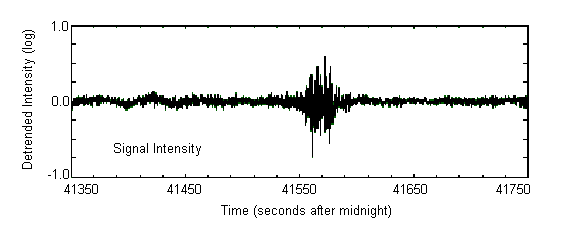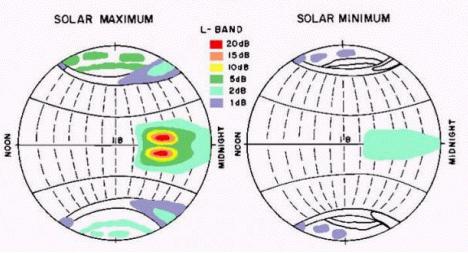 NWRA image
NWRA image
1 HISTORY
Ionospheric scintillations were first discovered in radio astronomical observations of Cygnus-A at 64 MHz. At first they were thought to be source scintillations, but later it was found that the scintillations over a 4-km baseline were correlated, whereas over a 210 km baseline they were not:
JS Hey, SJ Parsons and JW Phillips, "Fluctuations in Cosmic Radiation at Radiofrequencies", Nature, 158, 247 (1946)
FG Smith, GC Little and ACB Lovell, "Origin of the Fluctuations in the Intensity of Radio Waves from Galactic Sources", Nature, 165, 422-424 (1950).
Following the launch of Sputnik 1 in 1957, much ionospheric scintillation research has been conducted using satellite radio beacons. Two of the earliest papers on scintillations of satellite radio signals are:
GS Kent, "High-Frequency Fading Observed on the 40 Mc/s Wave Radiated from Artificial Satellite 1957a", J Atmospheric and Terrestrial Physics, 16, 10-20 (1959)
KC Yeh and GW Swenson Jr, "The Scintillation of Radio Signals from Satellites", J Geophys Res, 64, 2218-2286 (1959)
Hugh Chivers was probably the first to publish an explanation for scintillations in terms of ionospheric F region irregularities (as observed by ionosondes):
HJA Chivers, "Radio Star Scintillations and Spread-F Echoes", JATP, 25, 468-472 (1963)
The first Australian involvement in this field appears to be by Doug Singleton and Gordon Lynch reported in a 1962 paper:
DG Singleton and GJ Lynch, "The Scintillations of the Radio Transmissions from Explorer 7", JATP, 24, 353-374 (1962)
The first theory paper on ionospheric scintillations was coincident with the identification of the scintillation source:
HG Booker, JA Ratcliffe and DH Shinn, "Diffraction from an Irregular Screen with Applications to Ionospheric Problems", Philos Trans Roy Soc London, Series A, 242, 579-607 (1950)
The first comprehensive review of global ionospheric scintillations was published in 1971:
J Aarons, HS Whitney and RS Allen, "Global Morphology of Ionospheric Scintillation", Proc IEEE, 59, 159-172 (1971).
An updated review was published by Jules Aarons in the April 1982 issue of the Proceedings of the IEEE. This whole issue was devoted to ionospheric scintillations.
J Aarons, "Global Morphology of Ionospheric Scintillations", Proc IEEE, 70¸ 360-378 (1982)
Another review in the same issue, by Yeh and Liu, is very mathematical, but is worth reading for the many tidbits of information it contains, as well as the over 200 references it lists.
KC Yeh and C-H Liu, "Radio Wave Scintillations in the Ionosphere", Proc IEEE, 70, 324-360 (1982)
There is also good review material on ionospheric scintillations in Chapter 10 of the Air Force Geophysics Laboratory 'Handbook of Geophysics and the Space Environments', edited by Adolph S Jursa and published in 1985 (The Blue Book). Much of this material is by Jules Aarons and from his review paper noted above.
The easiest scintillation measurement is simply to monitor the amplitude or power of a received signal. This may be a radio astronomical source, or a satellite radio transmitter. This type of record gives the intensity of the scintillation.
 NWRA image
NWRA imageAnother interesting and useful measurement is to monitor the changes in phase of a stable signal. This requires a narrow band stable signal, such as a satellite beacon, and also a very frequency stable receiver. Not all satellite beacons are suitable, but only those with a high frequency stability. GPS satellites, which are frequency locked to atomic clocks, fall into this category and are now almost universally used for this type of measurement. The GPS receiver must also be stabilised, and this usually requires that the crystal oscillator be temperature controlled.
A useful paper that discusses a GPS system to collect and compute the S4 scintillation index is:
AJ van Dierendonck, J Klobuchar and Q Hua, "Ionospheric Scintillation Monitoring Using Commercial Single Frequency C/A Code Receivers", USAF Contract F19628-92-C-0139.
This was the precursor of the SCINDA scintillation monitoring system, also developed at AFRL.
Two indices have been used to quantify the intensity of ionospheric scintillations, SI (scintillation intensity) and S4.
SI was developed when data was reduced manually from chart records, whereas S4 is used most often now as data is reduced automatically using digital computers.
S4 = √ [ ( <I2> - <I>2 ) / <I>2 ]
Weak and strong scintillations
(Of course these designators may vary with the application, although the strong scintillation corresponds physical to strong scattering in the ionosphere. Some radio astronomy applications may suffer, eg image degradation even when S4 < 0.3)
Relationship between SI and S4
S4 = 0.071 SI0.8
In tabular form:
| S4 | SI(dB) |
| 0.075 | 1 |
| 0.17 | 3 |
| 0.3 | 6 |
| 0.45 | 10 |
| 0.6 | 15 |
Global distribution of scintillations

There are two main regions of prominent scintillation activity, around the auroral and polar zones and around the magnetic equator (note that the above digram is drawn in geomagnetic coordinates). Equatorial scintillation is more severe than auroral scintillation, particularly when the sunspot number is high. Equatorial scintillations are also an evening activity, with the activity mostly occurring between 2000 and 0200 local time. When this activity is mapped onto geographical coords, the difference between the magnetic and geographic equators can be clearly seen.
The plot below shows typical scintillation activity assuming a constant universal time at all longitudes (ie a snapshot of the ionospheric activity).

Some authors disregard mid-latitude scintillations since they are much smaller and less frequent than scintillations in the equatorial and auroral regions.
Lech Hajkowicz, at the University of Queensland, has probably collected more data on mid-latitude scintillations than most other researchers. He developed his own classification of mid-latitude. Unfortunately, because he never calibrated his data, his work has been largely ignored. It is worth studying, and his tutorial notes and data are still available at the website.
Download this material while you can, because it may disappear at any time, as UoQ has totally re-organised the Physics Department, and no longer has ionospheric interests.
Two main ionospheric scintillation models have been developed: WBMOD in the USA and GISM in Europe.
WBMOD
The WBMOD scintillation model was developed by scientists at NorthWest Research Associates, Inc (NRWA) under various USAF contracts. The initial model was developed using data from the US Defense Nuclear Agency (DNA) Wideband Satellite, which carried multiple beacons over a wide frequency range (138 to 2900 MHz).
The model is maintained at the National Space Science Data Center (NSSDC) at the NASA Goddard Space Flight Center (GSFC). However, it requires the permission of NRWA to be used (this is normally not a problem for non-commercial applications). The NRWA website (see below) has the email address to contact.
References to this model are found in:
EJ Fremouw and JA Secan, "Modeling and Scientific Application of Scintillation Results", Radio Sci, 19, 687-694 (1984)
JA Secan, RM Bussey, EJ Fremouw and S Basu, "An Improved Model of Equatorial Scintillation", Radio Sci, 30, 607-617 (1995)
JA Secan, RM Bussey, EJ Fremouw and S Basu, "High-Latitude Upgrade to the Wideband Ionospheric Scintillation Model", Radio Sci, 32, 1567-1574 (1997)
GISM
The Global Ionospheric Scintillation Model is a much more theoretical model than WBMOD. It was first described in the papers:
Y Beniguel and S Buono, "A Multiple Phase Screen Propagation Model to Estimate Fluctuations of Transmitted Signals", Phys Chem Earth (C), 24, 333-338 (1999)
Y Beniguel, "Global Ionospheric Propagation Model (GIM): A Propagation Model for Scintillations of Transmitted Radio Signals", Radio Sci, 37, RS1032, doi: 10.1029/2000RS002393 (2002)
GISM, being a theoretical model, does not agree with reality nearly as well as WBMOD. Unfortunately the Europeans have pushed to have GISM accepted as the international ionospheric scintillation model, and it is now listed as the ITU Report P.2097, and can be purchased from the same (if you are unlucky enough not to have downloaded the model prior to this event).
NWRA maintains a web site that has both tutorial material and real time data:
< www.nwra.com/research/ionosphere.php >
IPS also has both tutorial and real time data for the Australasian region:
< www.ips.gov.au/Satellite >
Some recent publications on ionospheric scintillations are:
M van de Kamp, P S Cannon, and M Terkildsen, "Effect of the Ionosphere on Defocusing of Space-Based Radars, Radio Sci., 44, RS1003, doi:10.1029/2007RS003808 (2009)
IM van Bemmel and H Röttgering, "Ionospheric Limitations for SKA and LOFAR", Proceedings of Science, PoS(MRU)012 (2007)
There are also many papers in pdf form on the web that can be downloaded:
www.cosmic.ucar.edu/colloquium_2004/.../Groves_23Jun04.pdf
waas.stanford.edu/~wwu/papers/gps/PDF/DattaBaruaIONGPS03.pdf
esa-spaceweather.net/spweather/workshops/SPW_W3/...W3/Aquino.pdf
www.dynamic-positioning.com/dp2000/sensors_marshall_pp.pdf
scintillations.cls.fr/
waas.stanford.edu/~wwu/papers/gps/PDF/SeoIBSS07.pdf
ssp.eleceng.adelaide.edu.au/public/theses/MKThesis.pdf
www.ieea.fr/help/gism-technical.pdf
plan.geomatics.ucalgary.ca/papers/05GNSS_Skone%20etal.pdf
www.ieea.fr/en/softwares/gism-ionospheric-model.html
http://www.itu.int/pub/R-REP-P.2097-2007
www.galileoic.org/la/files/WP200_D21_v1.1_StateoftheArtReview.pdf